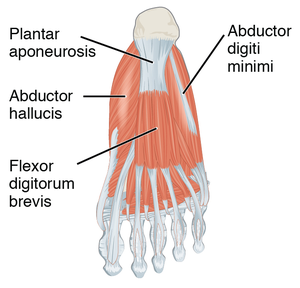Abductor Hallucis: Difference between revisions
Oyemi Sillo (talk | contribs) mNo edit summary |
Oyemi Sillo (talk | contribs) mNo edit summary |
||
| Line 5: | Line 5: | ||
</div> | </div> | ||
== Description == | == Description == | ||
Abductor Hallucis belongs to the superficial layer of the plantar foot muscles, alongside the Flexor Digitorum Brevis and Abductor Digiti Minimi. It contributes to the soft tissue prominence on the medial side of the sole.<ref name=":0">Standring S, ed. Gray's Anatomy: The Anatomical Basis of Clinical Practice, 40th ed. Edinburgh: Churchill-Livingstone, Elsevier, 2008 </ref> | Abductor Hallucis belongs to the superficial layer of the plantar foot muscles, alongside the Flexor Digitorum Brevis and Abductor Digiti Minimi.<ref name=":2" /> It contributes to the soft tissue prominence on the medial side of the sole.<ref name=":0">Standring S, ed. Gray's Anatomy: The Anatomical Basis of Clinical Practice, 40th ed. Edinburgh: Churchill-Livingstone, Elsevier, 2008 </ref> | ||
[[File:1124 Intrinsic Muscles of the Foot b.png|thumb]] | [[File:1124 Intrinsic Muscles of the Foot b.png|thumb]] | ||
| Line 21: | Line 21: | ||
== Function == | == Function == | ||
Abductor Hallucis flexes and abducts the large toe at the metatarsophalangeal joint.<ref>Jenkins DB. Hollinshead's Functional Anatomy of the Limbs and Back, 9th edition. Elsevier Health Services, 2008.</ref> | Abductor Hallucis flexes and abducts the large toe at the metatarsophalangeal joint.<ref name=":2">Jenkins DB. Hollinshead's Functional Anatomy of the Limbs and Back, 9th edition. Elsevier Health Services, 2008.</ref> | ||
== Clinical relevance == | == Clinical relevance == | ||
Revision as of 00:29, 30 September 2020
Original Editor - User Name
Top Contributors - Oyemi Sillo
Description[edit | edit source]
Abductor Hallucis belongs to the superficial layer of the plantar foot muscles, alongside the Flexor Digitorum Brevis and Abductor Digiti Minimi.[1] It contributes to the soft tissue prominence on the medial side of the sole.[2]
Origin[edit | edit source]
The Abductor Hallucis muscle originates from the medial process of calcaneal tuberosity, flexor retinaculum, and plantar aponeurosis.[2]
Insertion[edit | edit source]
It inserts on the medial aspect of the base of the proximal phalanx of large toe.[2]
Nerve[edit | edit source]
The Abductor Hallucis is supplied by the medial plantar nerve (S1 & S2), a terminal branch of the tibial nerve.[3]
Artery[edit | edit source]
The Abductor Hallucis is supplied by the medial plantar artery and the first plantar metatarsal artery.[3]
Function[edit | edit source]
Abductor Hallucis flexes and abducts the large toe at the metatarsophalangeal joint.[1]
Clinical relevance[edit | edit source]
As an intrinsic muscle of the foot, the Abductor Hallucis plays an important role in stabilising the medial longitudinal arch of the foot.[2]
References[edit | edit source]
- ↑ 1.0 1.1 Jenkins DB. Hollinshead's Functional Anatomy of the Limbs and Back, 9th edition. Elsevier Health Services, 2008.
- ↑ 2.0 2.1 2.2 2.3 Standring S, ed. Gray's Anatomy: The Anatomical Basis of Clinical Practice, 40th ed. Edinburgh: Churchill-Livingstone, Elsevier, 2008
- ↑ 3.0 3.1 Moore KL, Dalley AF, Agur AMR. Clinically Oriented Anatomy. Philadelphia: Lippincott Williams & Wilkins, 2013







